Table of Contents
Guide
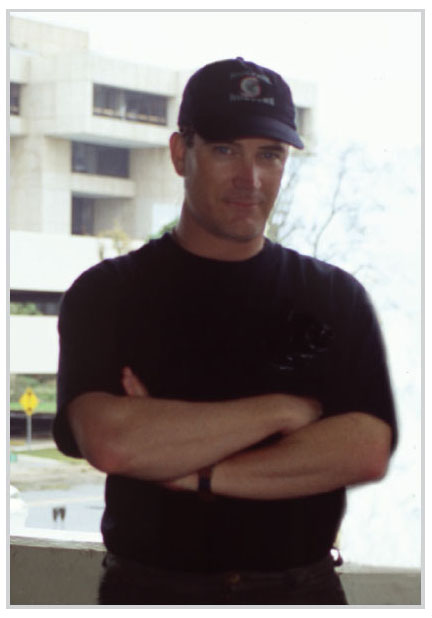
Warren Faidley is an extreme weather photojournalist, adventurer, and natural disaster survival expert. He is the first person to pursue storms and natural disasters as a full-time occupation. Over the course of the last 30 years, his hands-on experiences of outwitting dangerous situations has made him one of the worlds most sought-after experts on storm-and-disaster survival. His work has appeared on television shows and in hundreds of newspapers, advertisements, and magazines, including
National Geographic, CNN, Fox News, The Weather Channel, and the Discovery Channel. His image of a tornado near Miami, TX, was used as promotional cover art for the motion picture
Twister. Warrens interest in violent weather and adventure began at age 12, when he nearly lost his life after being carried away by a flash flood.
In 1988, he photographed a lightning bolt hitting a light pole less than 400 feet away from him. Life magazine published the image in 1989 and his career was launched. He formed the stock photography company Weatherstock Inc. in 1997, which became the worlds largest library of high-quality weather and storm images and footage. Warren is based out of Tucson, AZ. He graduated from the University of Arizona in 1989.
He is a pilot, ex-wildland firefighter, tactical EMT, and historical fencing instructor. He has won numerous awards and citations for his work and charitable contributions. The Start of a Career  This lightning photograph launched my career as an extreme weather photojournalist. Shot in Tucson, AZ, on October 16, 1988, the picture was the result of fighting off an angry colony of black widow spiders and a secondary lightning strike that nearly fried me. Captured from a mere 400 feet away, the picture remains the closest lightning strike ever captured on a medium format-sized transparency. In 1989, Life magazine published the image and billed me as a Storm Chaser.
This lightning photograph launched my career as an extreme weather photojournalist. Shot in Tucson, AZ, on October 16, 1988, the picture was the result of fighting off an angry colony of black widow spiders and a secondary lightning strike that nearly fried me. Captured from a mere 400 feet away, the picture remains the closest lightning strike ever captured on a medium format-sized transparency. In 1989, Life magazine published the image and billed me as a Storm Chaser.
Overnight, I began receiving requests from around the world for interviews and storm images. The demand never stopped. The Art of Visualization 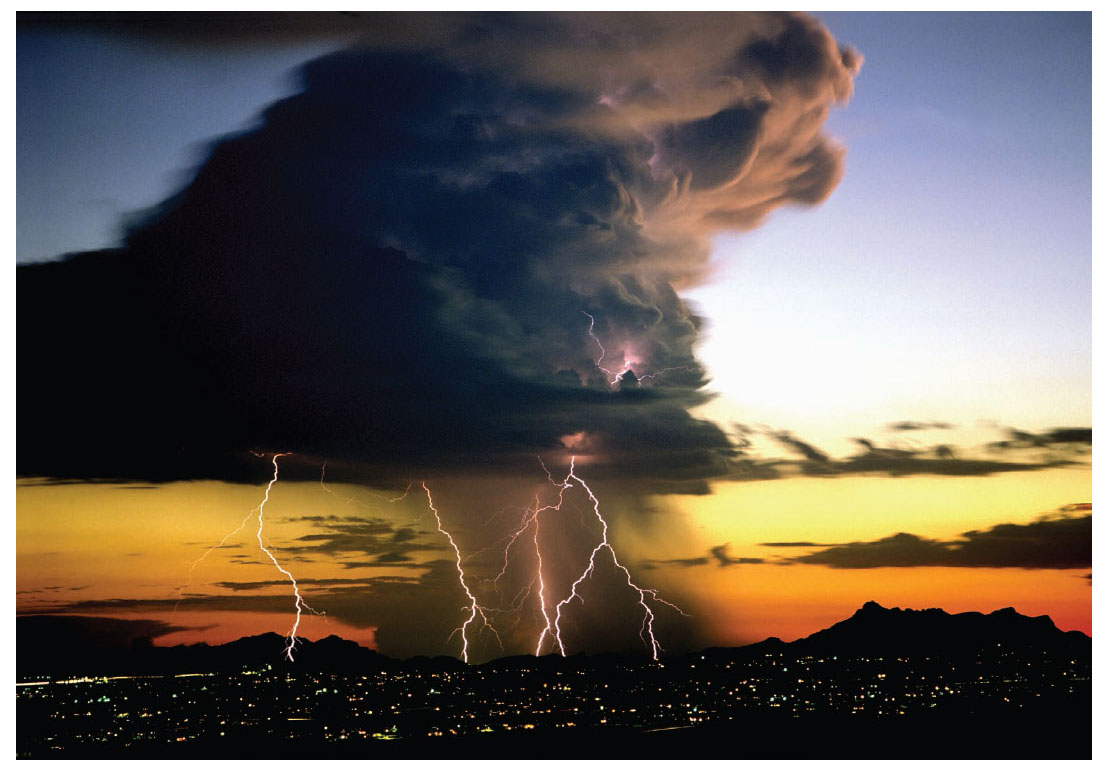 This is one of my favorite lightning shots. Many lightning pictures are accomplished after years of visualizing specific shots. I had imagined this type of thunderhead set against a sunset for years, until one lucky night when it all came together at the right time and place. As someone once said, Luck is the residue of design.
This is one of my favorite lightning shots. Many lightning pictures are accomplished after years of visualizing specific shots. I had imagined this type of thunderhead set against a sunset for years, until one lucky night when it all came together at the right time and place. As someone once said, Luck is the residue of design.
Seen from A Mountain in Tucson, AZ. The Early Days 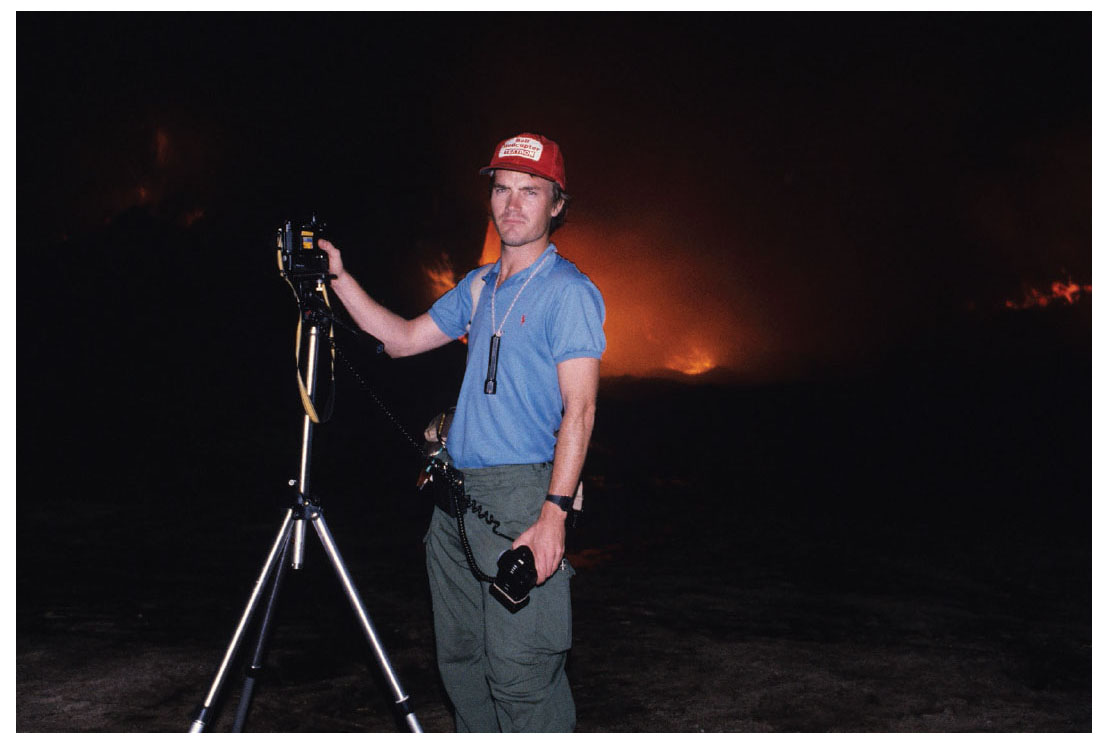 The early days of my photojournalism career. I started out shooting fires and disasters. I then sold the front-page images to competing newspapers until one finally gave in and hired me. My initial journalism work taught me to work under extreme conditions while staying out of trouble... most of the time! The Foothills
The early days of my photojournalism career. I started out shooting fires and disasters. I then sold the front-page images to competing newspapers until one finally gave in and hired me. My initial journalism work taught me to work under extreme conditions while staying out of trouble... most of the time! The Foothills 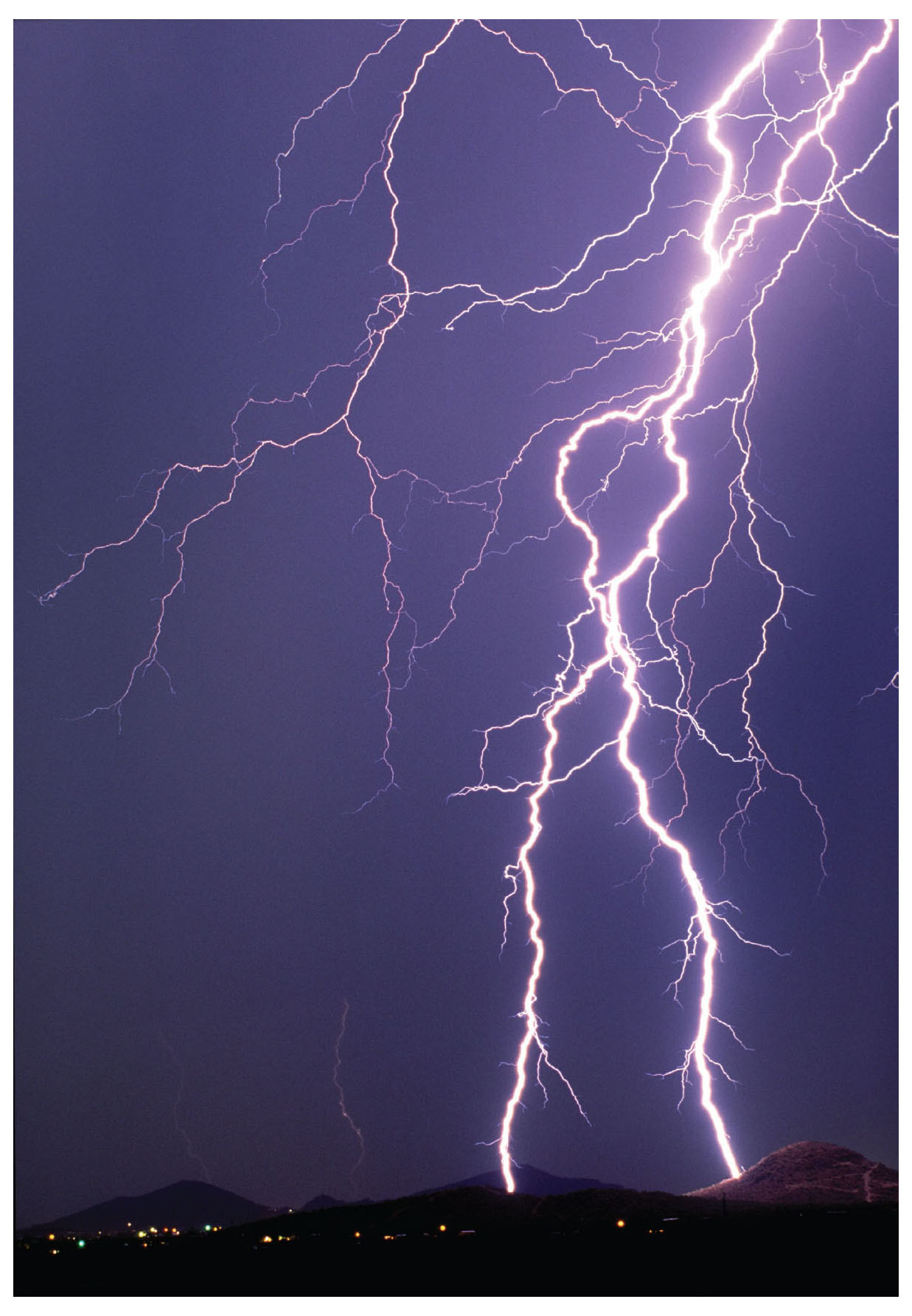 Lightning bolts strike the foothills south of Tuscon, AZ.
Lightning bolts strike the foothills south of Tuscon, AZ.
A Dangerous Pursuit  The unpredictable nature of lightning makes for a challenging and often dangerous pursuit. This unexpected bolt hit a tree less than a mile away from my camera on the University of Arizona Campus, Tucson. Natures Lightbulb
The unpredictable nature of lightning makes for a challenging and often dangerous pursuit. This unexpected bolt hit a tree less than a mile away from my camera on the University of Arizona Campus, Tucson. Natures Lightbulb 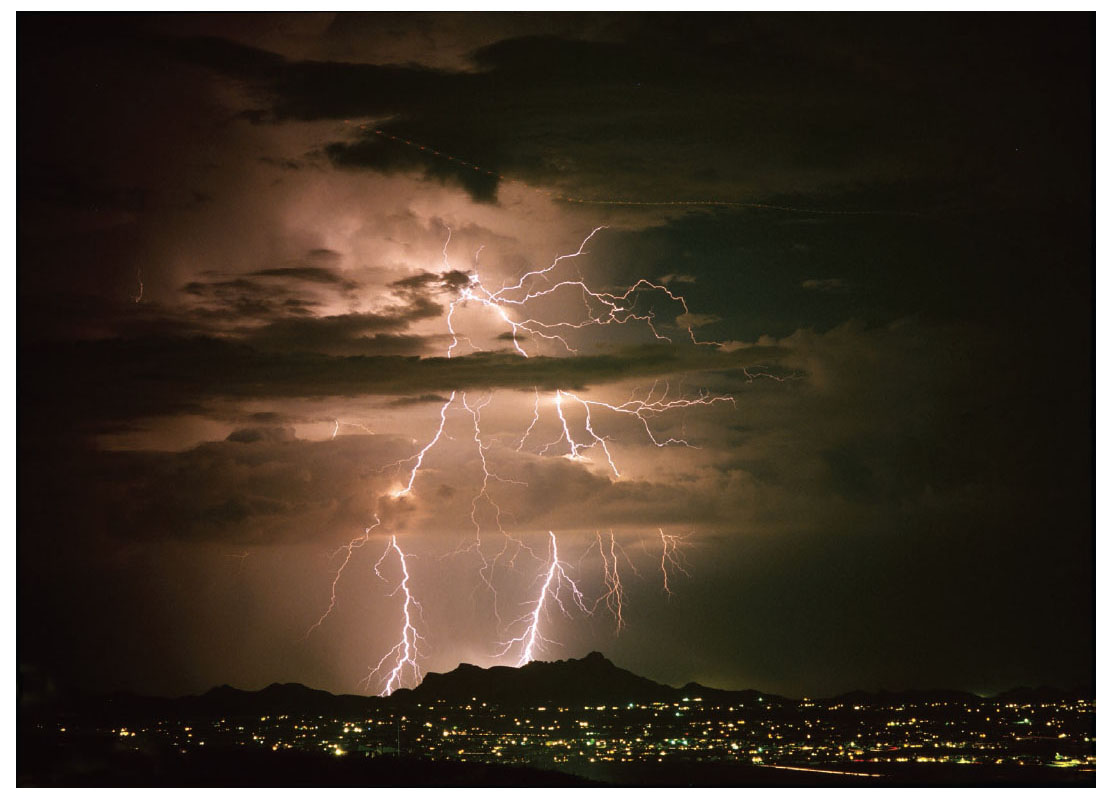 Thunderheads are my favorite lightning storms to photograph. The internal flashes often illuminate the clouds like a lightbulb, providing depth and contrasting colors. Most of the lightning shots seen in this book were shot on film. While I was taking this image in Tucson, AZ, a fellow photographer shooting next to me got so excited he accidentally kicked his tripod, nearly ruining his shot.
Thunderheads are my favorite lightning storms to photograph. The internal flashes often illuminate the clouds like a lightbulb, providing depth and contrasting colors. Most of the lightning shots seen in this book were shot on film. While I was taking this image in Tucson, AZ, a fellow photographer shooting next to me got so excited he accidentally kicked his tripod, nearly ruining his shot.
Fulgurite 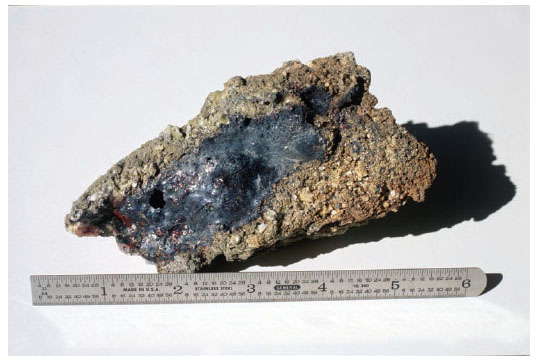 Lightning can generate extreme temperatures of over 50,000F, while the surface of the sun is a much cooler 10,000F. When a lightning bolt hits the ground, it can sometimes fuse sand and dirt into a hard rock material known as a fulgurite, like this one from southeast AZ. Secret to Success
Lightning can generate extreme temperatures of over 50,000F, while the surface of the sun is a much cooler 10,000F. When a lightning bolt hits the ground, it can sometimes fuse sand and dirt into a hard rock material known as a fulgurite, like this one from southeast AZ. Secret to Success 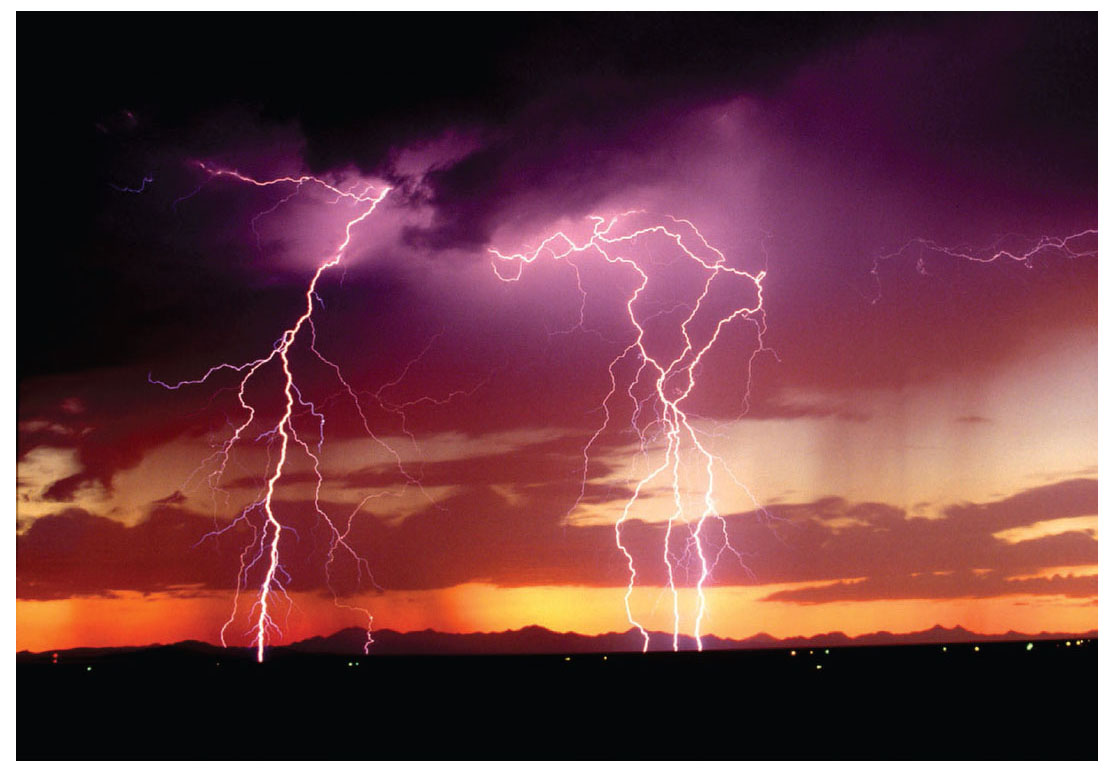 My formula for shooting lightning is very simple: Dont get killed and dont step on anything that can bite back. Over the years, Ive encountered spiders, rattlesnakes, killer bees, and stray gunfire. My exposures are always based on existing light. I measure the light and set the exposure.
My formula for shooting lightning is very simple: Dont get killed and dont step on anything that can bite back. Over the years, Ive encountered spiders, rattlesnakes, killer bees, and stray gunfire. My exposures are always based on existing light. I measure the light and set the exposure.
I always try for the longest exposure possible to increase the odds of capturing a discharge. My f-stops are almost always f/4.5 or f/5.6, as closing the shutter too much makes the lightning bolts look thin. The good thing about digital cameras (as opposed to old film cameras) is that you can instantly test and review exposures. I often wonder how many pictures I missed while fiddling with film cameras. Color and Depth  Unlike the flat landscapes of the Plains and Florida, the mountainous landscapes of the southwestern U.S. provide excellent backdrops for lightning photography.
Unlike the flat landscapes of the Plains and Florida, the mountainous landscapes of the southwestern U.S. provide excellent backdrops for lightning photography.
Without the mountains, this image shot near Tucson, AZ, would be much less dramatic. Close to Home 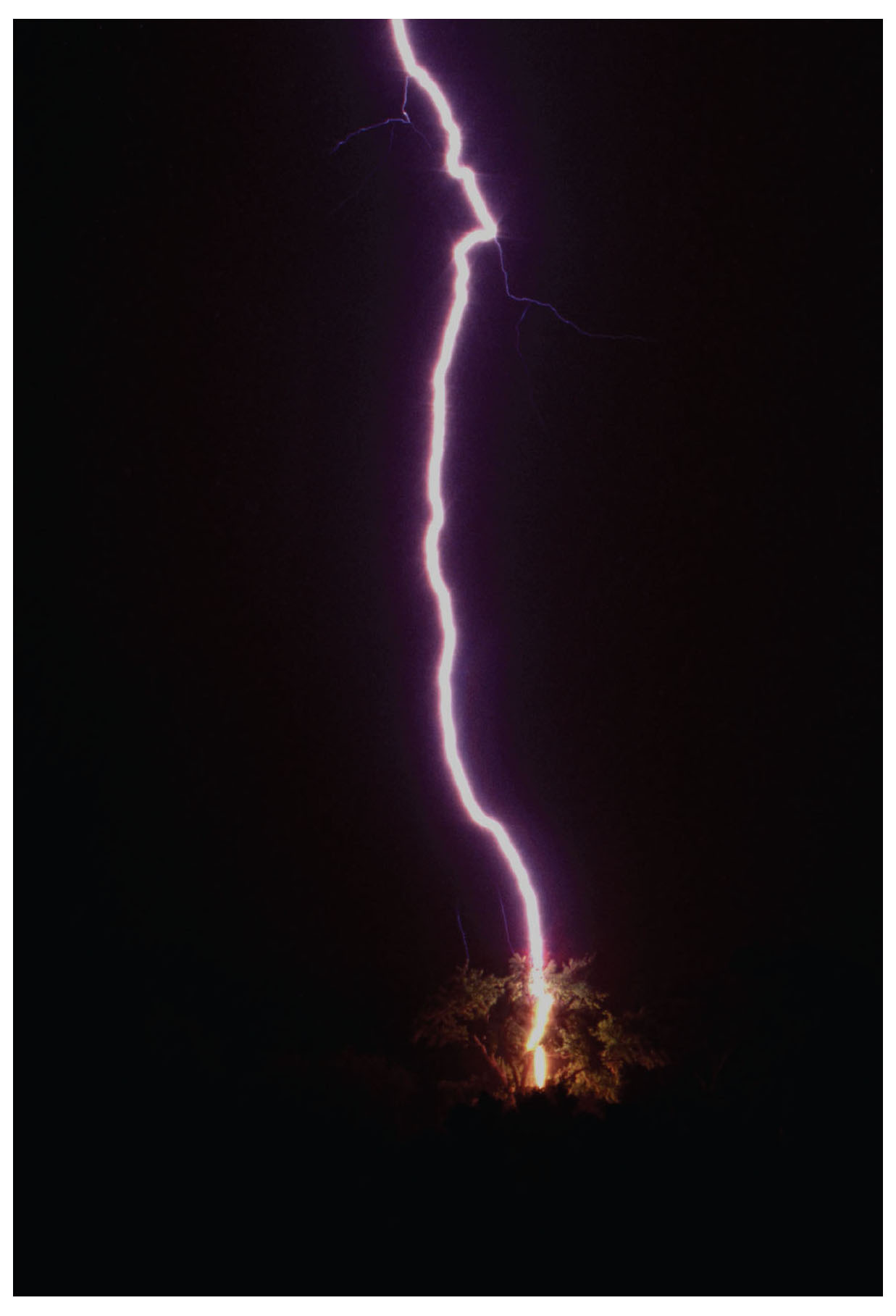 Sometimes you dont need to travel far to end up with a great image. I shot this nearby lightning bolt hitting a tree behind my home in Tucson from the semi-safety of an upstairs bedroom with a cool drink in my hand. Sunset and Ash
Sometimes you dont need to travel far to end up with a great image. I shot this nearby lightning bolt hitting a tree behind my home in Tucson from the semi-safety of an upstairs bedroom with a cool drink in my hand. Sunset and Ash 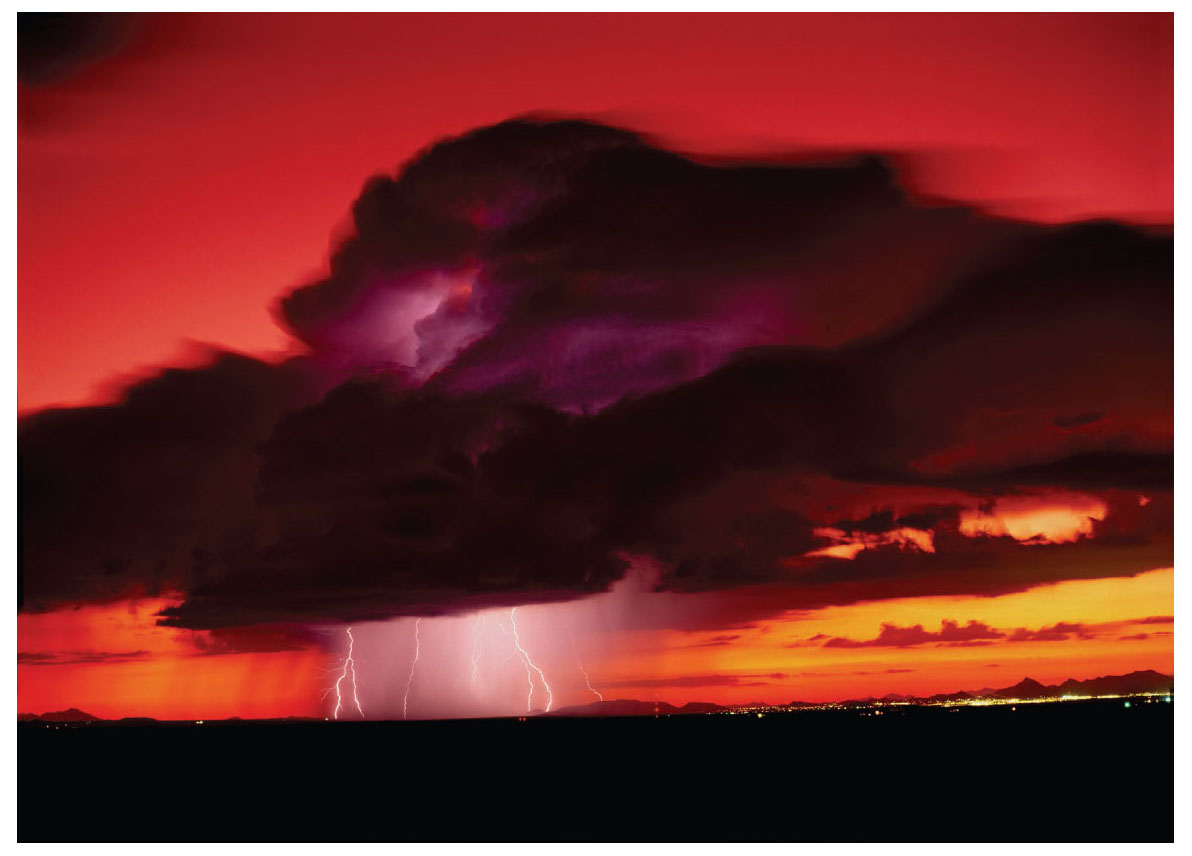 The blood-red backdrop for this thunderhead in Tucson was provided in part by a sunset enhanced by volcanic ash from the Mt. Pinatubo eruption in 1991. I rarely use filters for lightning photography.
The blood-red backdrop for this thunderhead in Tucson was provided in part by a sunset enhanced by volcanic ash from the Mt. Pinatubo eruption in 1991. I rarely use filters for lightning photography.
Attraction  Power grids attract two things: lightning bolts and Godzilla. This long exposure of greater than 2 minutes captured a very active monsoon storm that produced several hundred lightning strikes. Southeast Arizona. Shocking!
Power grids attract two things: lightning bolts and Godzilla. This long exposure of greater than 2 minutes captured a very active monsoon storm that produced several hundred lightning strikes. Southeast Arizona. Shocking!  Workers at this copper smelter near Mammoth, AZ, were undoubtedly startled when a very powerful lighting bolt struck the plant in the middle of the night. The first lightning strike of a thunderstorm is often the most dangerous, as people are not always expecting it. Simla, Colorado
Workers at this copper smelter near Mammoth, AZ, were undoubtedly startled when a very powerful lighting bolt struck the plant in the middle of the night. The first lightning strike of a thunderstorm is often the most dangerous, as people are not always expecting it. Simla, Colorado 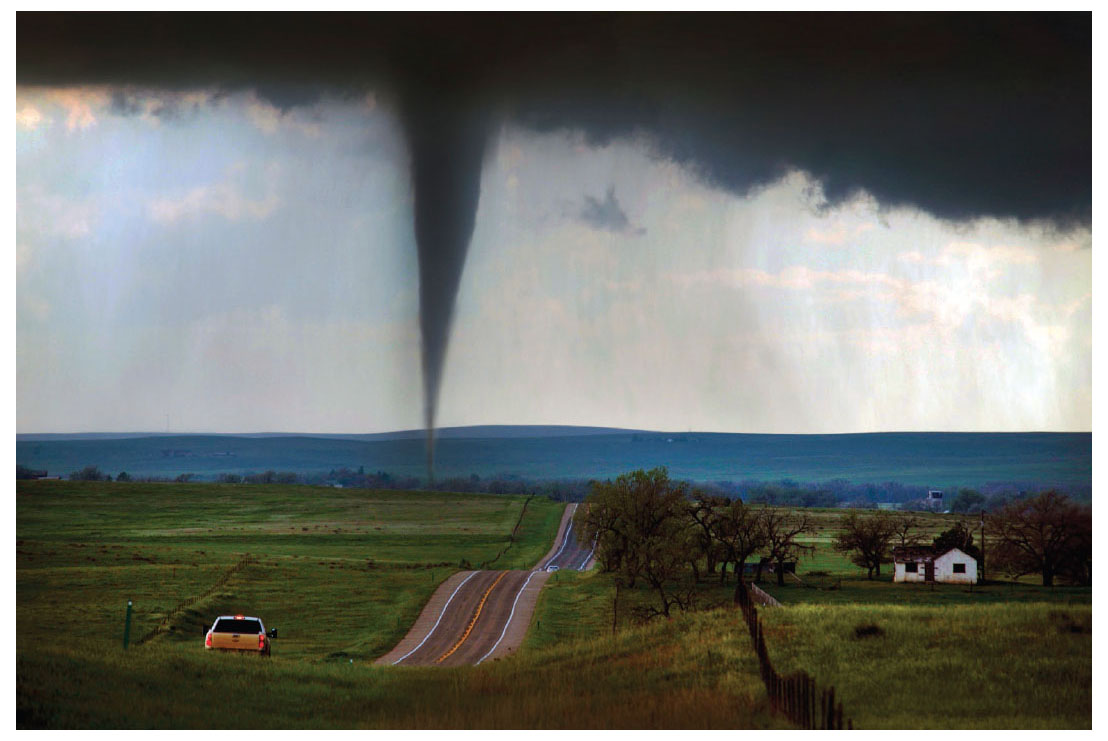
Next page

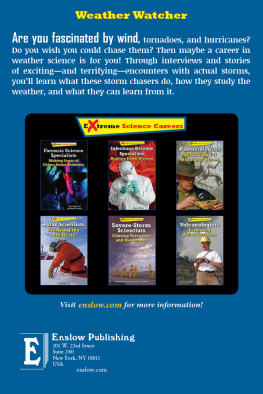

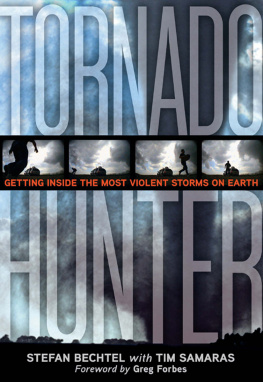
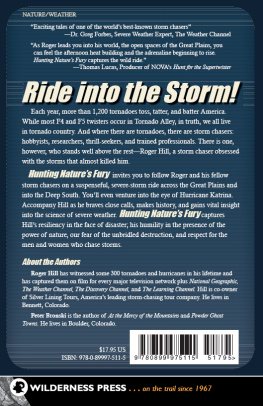
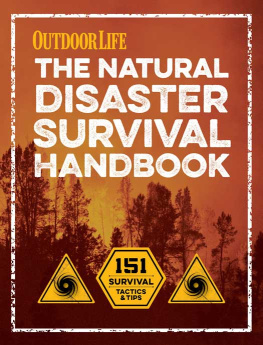
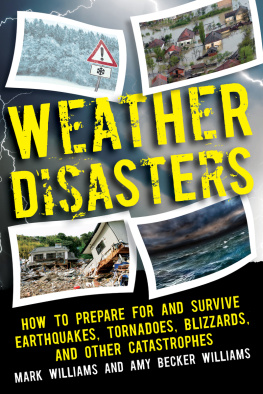
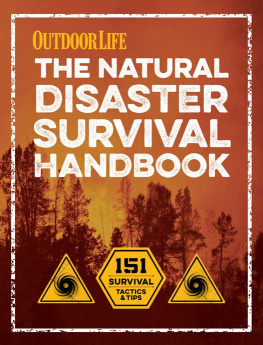
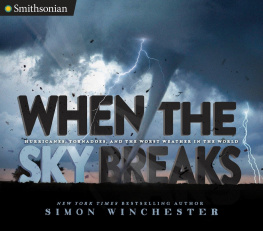
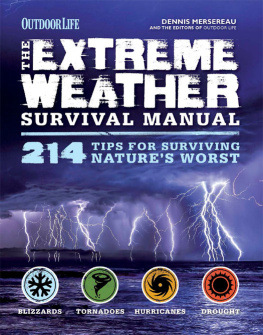
 Warren Faidley is an extreme weather photojournalist, adventurer, and natural disaster survival expert. He is the first person to pursue storms and natural disasters as a full-time occupation. Over the course of the last 30 years, his hands-on experiences of outwitting dangerous situations has made him one of the worlds most sought-after experts on storm-and-disaster survival. His work has appeared on television shows and in hundreds of newspapers, advertisements, and magazines, including National Geographic, CNN, Fox News, The Weather Channel, and the Discovery Channel. His image of a tornado near Miami, TX, was used as promotional cover art for the motion picture Twister. Warrens interest in violent weather and adventure began at age 12, when he nearly lost his life after being carried away by a flash flood.
Warren Faidley is an extreme weather photojournalist, adventurer, and natural disaster survival expert. He is the first person to pursue storms and natural disasters as a full-time occupation. Over the course of the last 30 years, his hands-on experiences of outwitting dangerous situations has made him one of the worlds most sought-after experts on storm-and-disaster survival. His work has appeared on television shows and in hundreds of newspapers, advertisements, and magazines, including National Geographic, CNN, Fox News, The Weather Channel, and the Discovery Channel. His image of a tornado near Miami, TX, was used as promotional cover art for the motion picture Twister. Warrens interest in violent weather and adventure began at age 12, when he nearly lost his life after being carried away by a flash flood.  This lightning photograph launched my career as an extreme weather photojournalist. Shot in Tucson, AZ, on October 16, 1988, the picture was the result of fighting off an angry colony of black widow spiders and a secondary lightning strike that nearly fried me. Captured from a mere 400 feet away, the picture remains the closest lightning strike ever captured on a medium format-sized transparency. In 1989, Life magazine published the image and billed me as a Storm Chaser.
This lightning photograph launched my career as an extreme weather photojournalist. Shot in Tucson, AZ, on October 16, 1988, the picture was the result of fighting off an angry colony of black widow spiders and a secondary lightning strike that nearly fried me. Captured from a mere 400 feet away, the picture remains the closest lightning strike ever captured on a medium format-sized transparency. In 1989, Life magazine published the image and billed me as a Storm Chaser. This is one of my favorite lightning shots. Many lightning pictures are accomplished after years of visualizing specific shots. I had imagined this type of thunderhead set against a sunset for years, until one lucky night when it all came together at the right time and place. As someone once said, Luck is the residue of design.
This is one of my favorite lightning shots. Many lightning pictures are accomplished after years of visualizing specific shots. I had imagined this type of thunderhead set against a sunset for years, until one lucky night when it all came together at the right time and place. As someone once said, Luck is the residue of design. The early days of my photojournalism career. I started out shooting fires and disasters. I then sold the front-page images to competing newspapers until one finally gave in and hired me. My initial journalism work taught me to work under extreme conditions while staying out of trouble... most of the time! The Foothills
The early days of my photojournalism career. I started out shooting fires and disasters. I then sold the front-page images to competing newspapers until one finally gave in and hired me. My initial journalism work taught me to work under extreme conditions while staying out of trouble... most of the time! The Foothills  Lightning bolts strike the foothills south of Tuscon, AZ.
Lightning bolts strike the foothills south of Tuscon, AZ. The unpredictable nature of lightning makes for a challenging and often dangerous pursuit. This unexpected bolt hit a tree less than a mile away from my camera on the University of Arizona Campus, Tucson. Natures Lightbulb
The unpredictable nature of lightning makes for a challenging and often dangerous pursuit. This unexpected bolt hit a tree less than a mile away from my camera on the University of Arizona Campus, Tucson. Natures Lightbulb  Thunderheads are my favorite lightning storms to photograph. The internal flashes often illuminate the clouds like a lightbulb, providing depth and contrasting colors. Most of the lightning shots seen in this book were shot on film. While I was taking this image in Tucson, AZ, a fellow photographer shooting next to me got so excited he accidentally kicked his tripod, nearly ruining his shot.
Thunderheads are my favorite lightning storms to photograph. The internal flashes often illuminate the clouds like a lightbulb, providing depth and contrasting colors. Most of the lightning shots seen in this book were shot on film. While I was taking this image in Tucson, AZ, a fellow photographer shooting next to me got so excited he accidentally kicked his tripod, nearly ruining his shot. Lightning can generate extreme temperatures of over 50,000F, while the surface of the sun is a much cooler 10,000F. When a lightning bolt hits the ground, it can sometimes fuse sand and dirt into a hard rock material known as a fulgurite, like this one from southeast AZ. Secret to Success
Lightning can generate extreme temperatures of over 50,000F, while the surface of the sun is a much cooler 10,000F. When a lightning bolt hits the ground, it can sometimes fuse sand and dirt into a hard rock material known as a fulgurite, like this one from southeast AZ. Secret to Success  My formula for shooting lightning is very simple: Dont get killed and dont step on anything that can bite back. Over the years, Ive encountered spiders, rattlesnakes, killer bees, and stray gunfire. My exposures are always based on existing light. I measure the light and set the exposure.
My formula for shooting lightning is very simple: Dont get killed and dont step on anything that can bite back. Over the years, Ive encountered spiders, rattlesnakes, killer bees, and stray gunfire. My exposures are always based on existing light. I measure the light and set the exposure. Unlike the flat landscapes of the Plains and Florida, the mountainous landscapes of the southwestern U.S. provide excellent backdrops for lightning photography.
Unlike the flat landscapes of the Plains and Florida, the mountainous landscapes of the southwestern U.S. provide excellent backdrops for lightning photography. Sometimes you dont need to travel far to end up with a great image. I shot this nearby lightning bolt hitting a tree behind my home in Tucson from the semi-safety of an upstairs bedroom with a cool drink in my hand. Sunset and Ash
Sometimes you dont need to travel far to end up with a great image. I shot this nearby lightning bolt hitting a tree behind my home in Tucson from the semi-safety of an upstairs bedroom with a cool drink in my hand. Sunset and Ash  The blood-red backdrop for this thunderhead in Tucson was provided in part by a sunset enhanced by volcanic ash from the Mt. Pinatubo eruption in 1991. I rarely use filters for lightning photography.
The blood-red backdrop for this thunderhead in Tucson was provided in part by a sunset enhanced by volcanic ash from the Mt. Pinatubo eruption in 1991. I rarely use filters for lightning photography. Power grids attract two things: lightning bolts and Godzilla. This long exposure of greater than 2 minutes captured a very active monsoon storm that produced several hundred lightning strikes. Southeast Arizona. Shocking!
Power grids attract two things: lightning bolts and Godzilla. This long exposure of greater than 2 minutes captured a very active monsoon storm that produced several hundred lightning strikes. Southeast Arizona. Shocking!  Workers at this copper smelter near Mammoth, AZ, were undoubtedly startled when a very powerful lighting bolt struck the plant in the middle of the night. The first lightning strike of a thunderstorm is often the most dangerous, as people are not always expecting it. Simla, Colorado
Workers at this copper smelter near Mammoth, AZ, were undoubtedly startled when a very powerful lighting bolt struck the plant in the middle of the night. The first lightning strike of a thunderstorm is often the most dangerous, as people are not always expecting it. Simla, Colorado 